TRAVEL MEMORIES
Siena and the horse race that drives locals wild
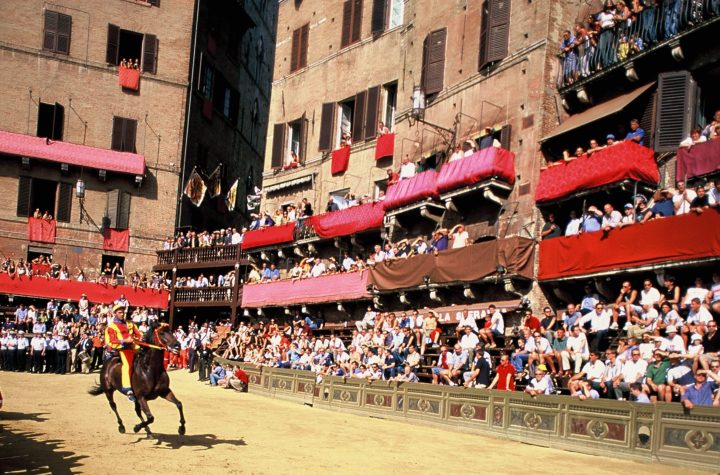
There’s a crazy bareback horse race through the streets of an ancient, jaw-droppingly beautiful Italian town that’s as mad as its pageantry is spectacular.
Imagine a dangerous bareback horse race with more than 700 years of tradition behind it – and few rules. Imagine the track to be round the central piazza of one of the most beautiful medieval cities in the world.
Add knights with jousting lances mounted on massive chargers and clad in full armour, swordsmen, bowmen, flag twirlers, crossbowmen and an impossibly old cart pulled by massive bullocks bearing a silk banner for which the riders compete. Stir in Italian passion, subtract tourists (they’re deemed irrelevant) and you will hardly have begun to visualise the raw excitement or roaring splendour of Siena’s Palio.
Busing up from Rome, the countryside changed from urban through industrial to chocolate-box Tuscany. The geometry of the landscape and artist’s palette of colours were strangely familiar but puzzling, until it dawned that this was the living backdrop of Renaissance art.
The Etruscans, who predated the Tuscans, were hilltop dwellers by necessity. Living in troubled times, they built their farmhouses like fortresses atop the countless rolling hills. Many of these became villages, then small, walled cities.
The need to peer over the surrounding wooded valleys and fields led to the construction of tall watchtowers. By the 13th century, a time of Tuscan prosperity, tower building became a mania of the wealthy, keen to display their power and virility. Today every village seems to have several, with a particularly splendid crop in San Gimignano, where the film Tea with Mussolini was set.
Place of the one-handed clock
Siena announced itself with a candy-striped cathedral tower and an even higher Tower of Mangia, replete with an old-style one-handed clock. Apart from the scooters and people, there was little to remind you that this was the 21st – or even the 13th – century.
“Buon giorno. Volete caffè?” enquired the waiter in the pavement café below Hotel Centrale, the small roof-top pension we’d checked into. Italians understand coffee the way they understand ice cream and pasta: substances for oral seduction.
Gelateria “Il Camerlengo”, reputed to be the city’s best ice cream dispenser, is a long, narrow shop opening onto the Piazza del Campo and is filled with tantalising flavours. You can choose between rocher chocolate and pistachio, hazelnut, veneziana (glazed oranges, vanilla and Nutella), cherry yogurt and even green apple. Owner and ice cream maker Hasib constantly invents new flavours and the pretty signorine behind the counter are generous with their servings. It’s the sort of establishment that soon turns you into a regular. The Gelateria also serves coffees, sandwiches and aperitivos and is often filled with locals swapping news and gossip. It doesn’t take long to notice how well turned out Italians are. They have a well-groomed, confident style that pays little heed to the basics they’re born with. When they walk down the street, dark eyes flashing, immaculate, you’d swear they were doing it to the strains of Verdi’s Aida or perhaps Vivaldi’s rendition of spring.
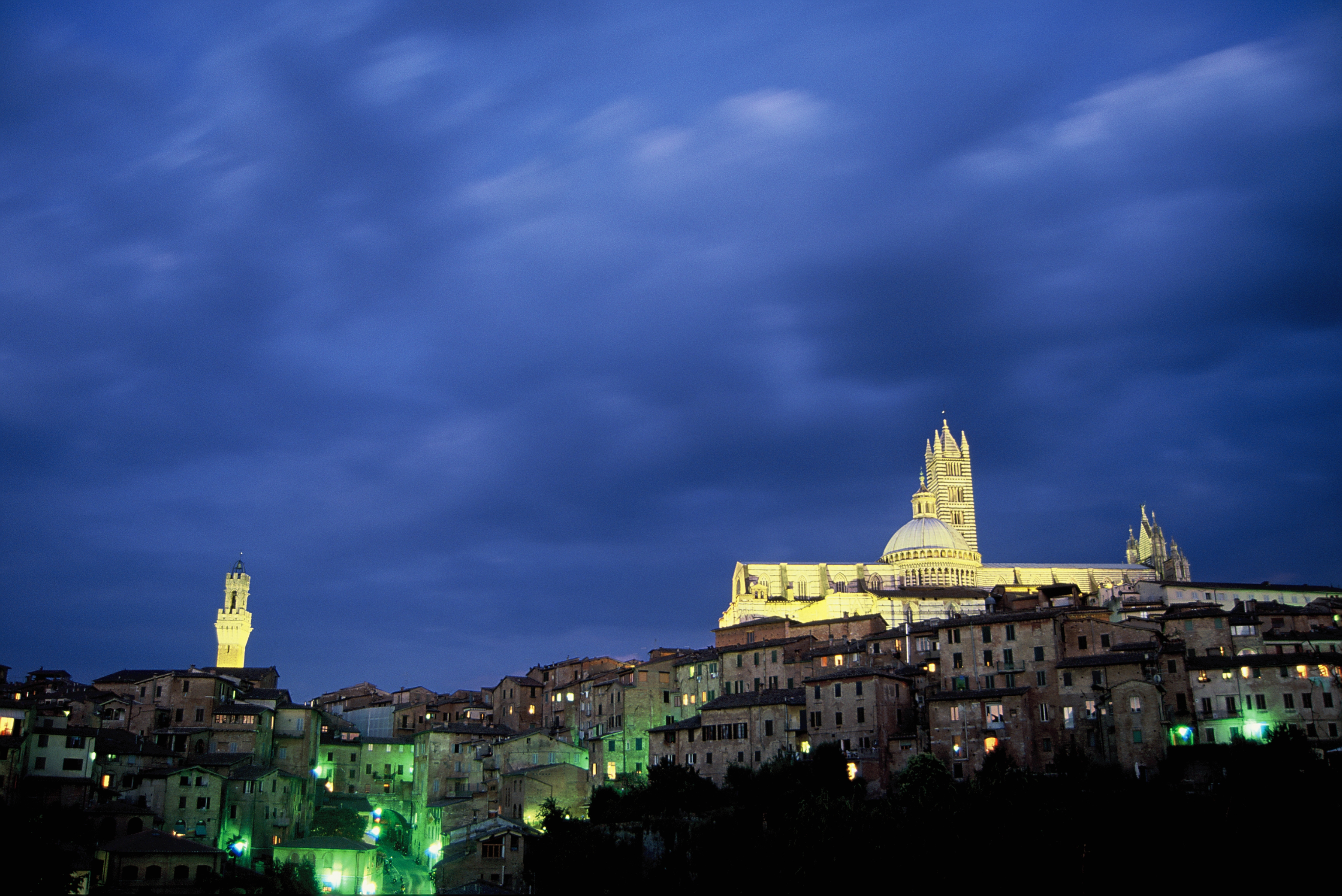
Siena is one of Italy’s most beautiful towns. Image: Don Pinnock
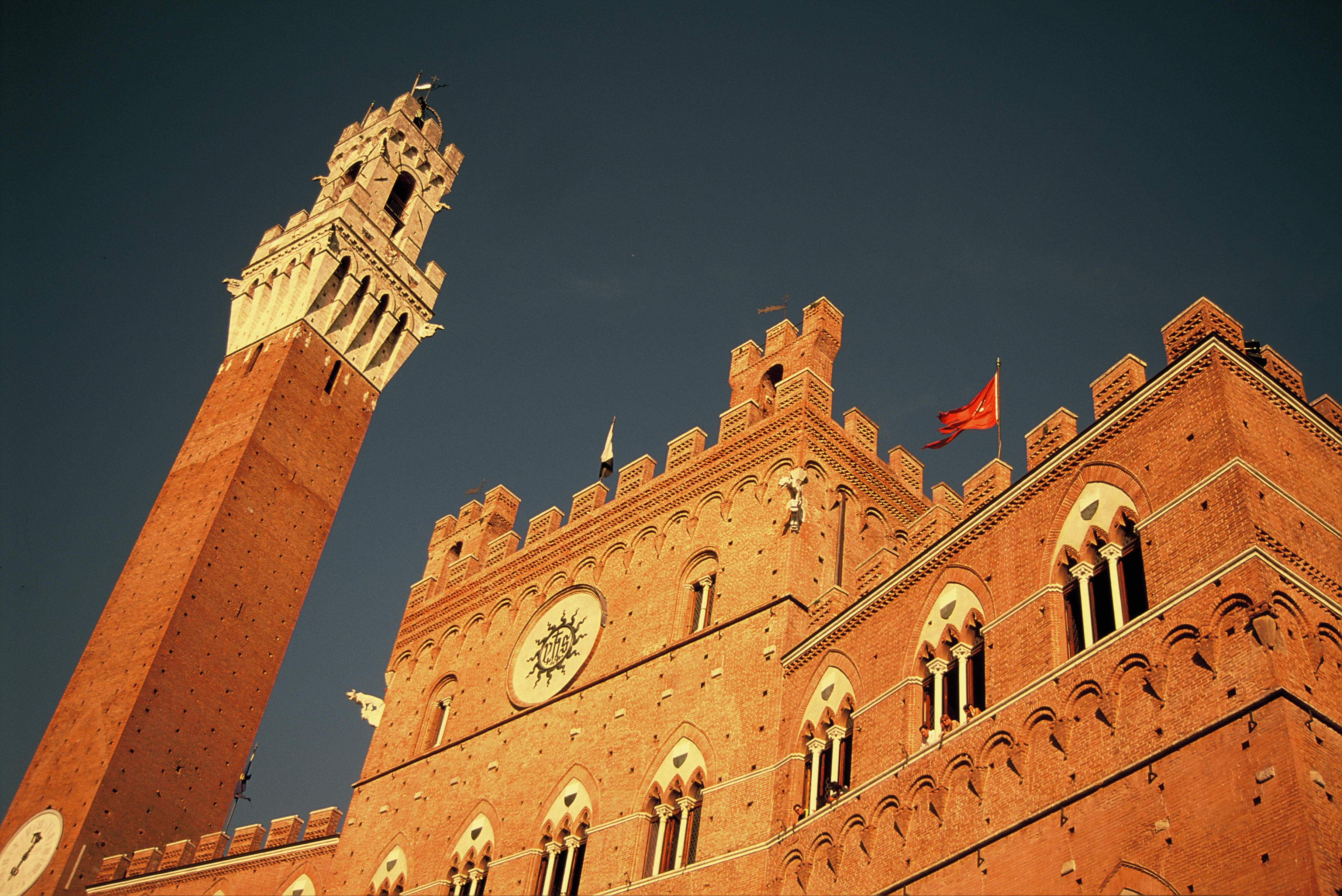
Siena’s glorious Torre del Mangia built in 1338-1348. Image: Don Pinnock
There is a particularly pleasing shape to il Campo (the field), which is the heart of Siena’s cultural life. From above it looks like a giant shell, with channels built in the 13th century to conduit rainwater at a place where the three hills on which the city is built meet. It is covered in bricks set in a wishbone pattern and surrounded by beautiful old buildings dominated by the Palazzo Pubblico (Public Palace) and its looming Tower of Mangia. The campo is generally regarded as the finest example of a medieval piazza in Italy and it is here, twice a year, that the madness of the Palio takes place.
Pomp of the Palio
It is not clear when the race, and its attendant festival, began, but there are definite records of its existence from 1310. Its probable origins were the celebrations following the battle of Montaperti, where the Sienese trounced the Florentines, an event which saw the beginning of Siena’s golden age of art, architecture and commerce.
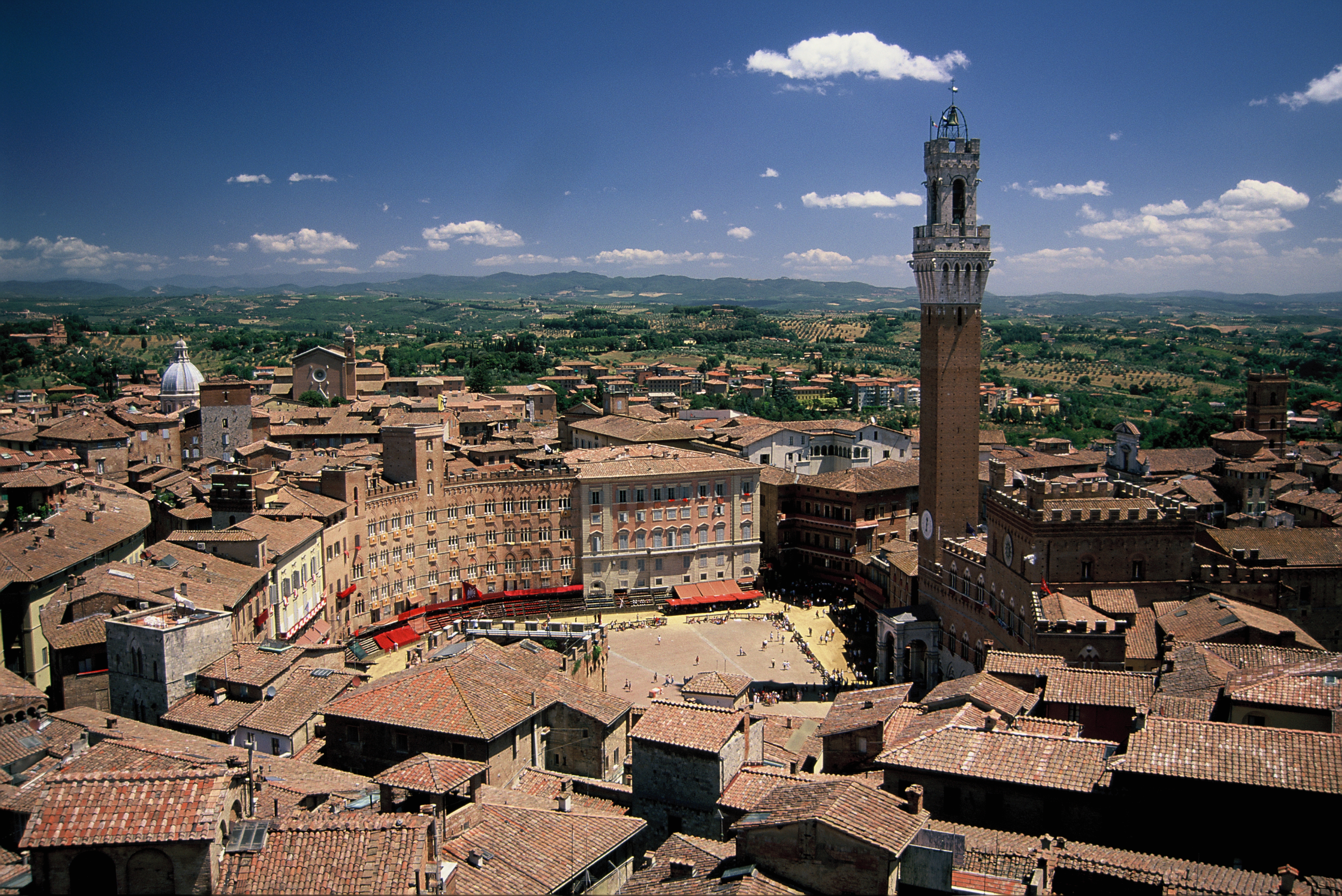
Siena’s Campo transformed into a race track. Image: Don Pinnock
The formalisation of the event, however, seems to have taken place in the 17th century with the decline of central government in the Middle Ages. To protect themselves, citizens formed themselves into contradas (districts) and it is these that now compete and organise the spectacular feasts and parades that precede the event.
Our visit, in 2012, coincided with the July Palio (there is another one each August). The campo was fenced off to form a track around its perimeter and the cobbles and bricks were covered in clay.
Strolling through the streets, we would suddenly be confronted by a gaudily blanketed horse followed by dozens of singing contrada members, or men in medieval costumes, flags flying and singing themselves loudly down a narrow street. Each contrada has its own piazza, club house and chapel. On one occasion, we were unable to enter our hotel for about an hour because a contrada’s horse was being given holy communion in the chapel across the street.
The rules of the race are anarchic. Contradas bid and bargain for horses which are loaned for the event. Jockeys can be from anywhere and they are assigned by names pulled out of a hat. They ride bareback with no stirrups, are adored and written into tradition if they win and hated if they lose. A blind eye is turned to cheating. If a rider falls off and his horse is first past the post, that contrada still wins. It’s all about the horses.
Night of the banquets
During the weeks before the event, streets are blocked off in the seven competing contradas. Huge banquets are held, with almost unbelievable amounts of mouthwatering food and wine.
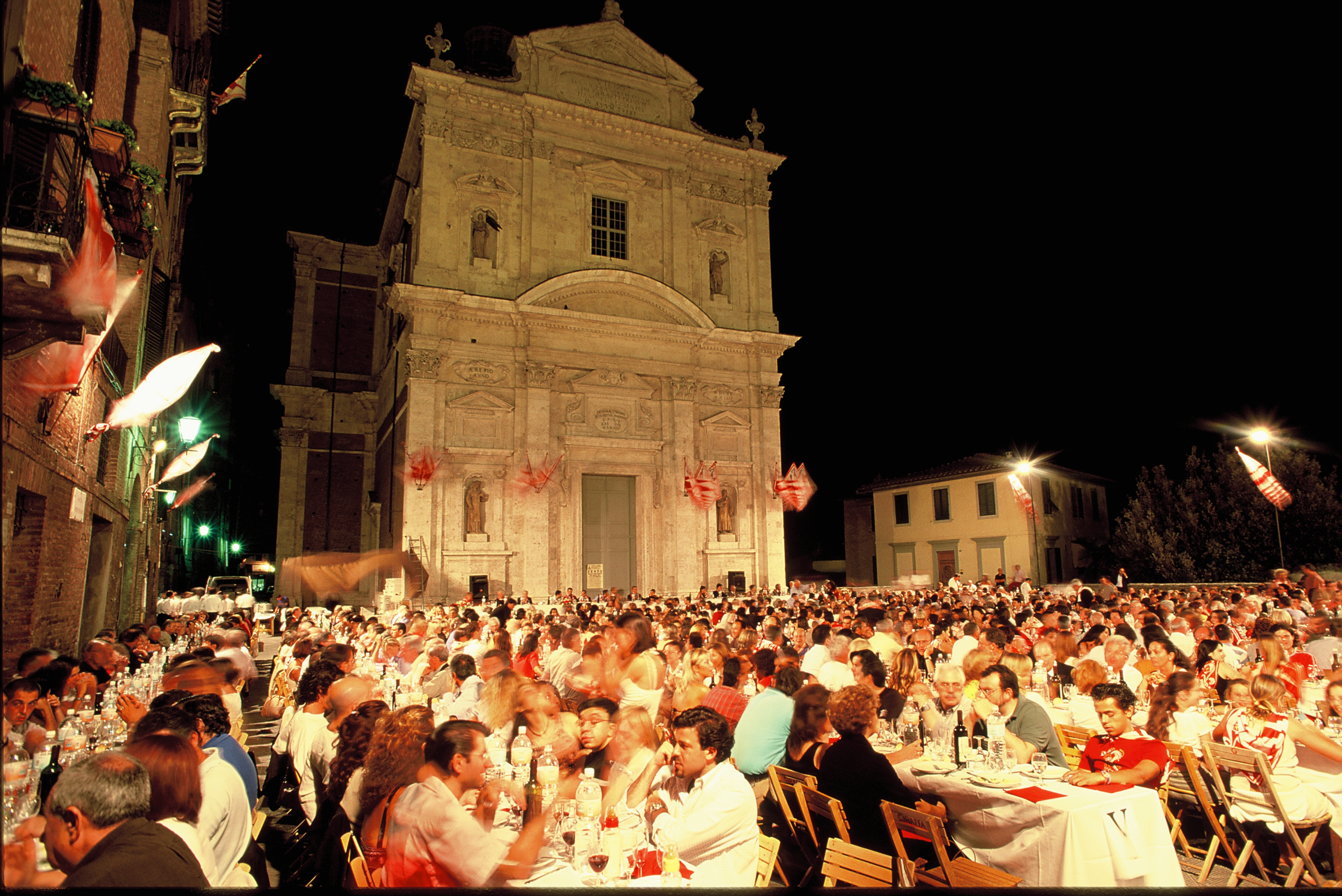
Palio pre-race parties are serious business. Image: Don Pinnock
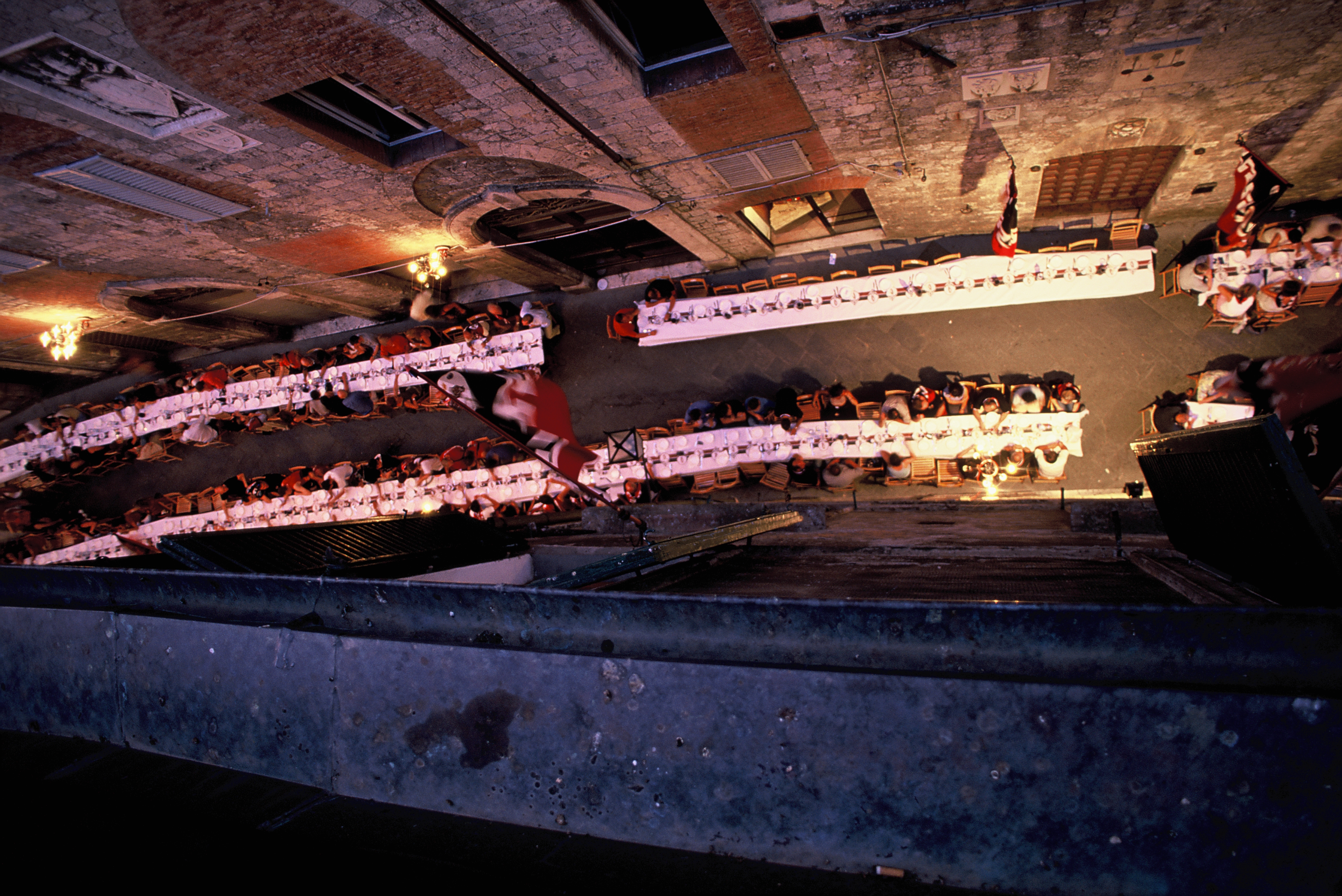
An all-essential contrada race party. Image: Don Pinnock
Early on the day of the race crowds gathered in the square, contrada members sitting on raised stands on the perimeter of the track and the rest bunched into the centre of the campo. About midday the atmosphere became incandescent.
What followed was completely extraordinary. Gloriously attired warriors on magnificent steeds burst from the arches of the Palace and mounted a full-speed cavalry charge around the track. Then followed the troops of contrada after contrada, all in medieval costume and carrying ancient weapons of war.
Finally the race-ready horses appeared to a deafening roar from the crowd. Much fuss took place while they lined up at a rope across the track and there was one false start that drove the yelling and booing crowd crazy.
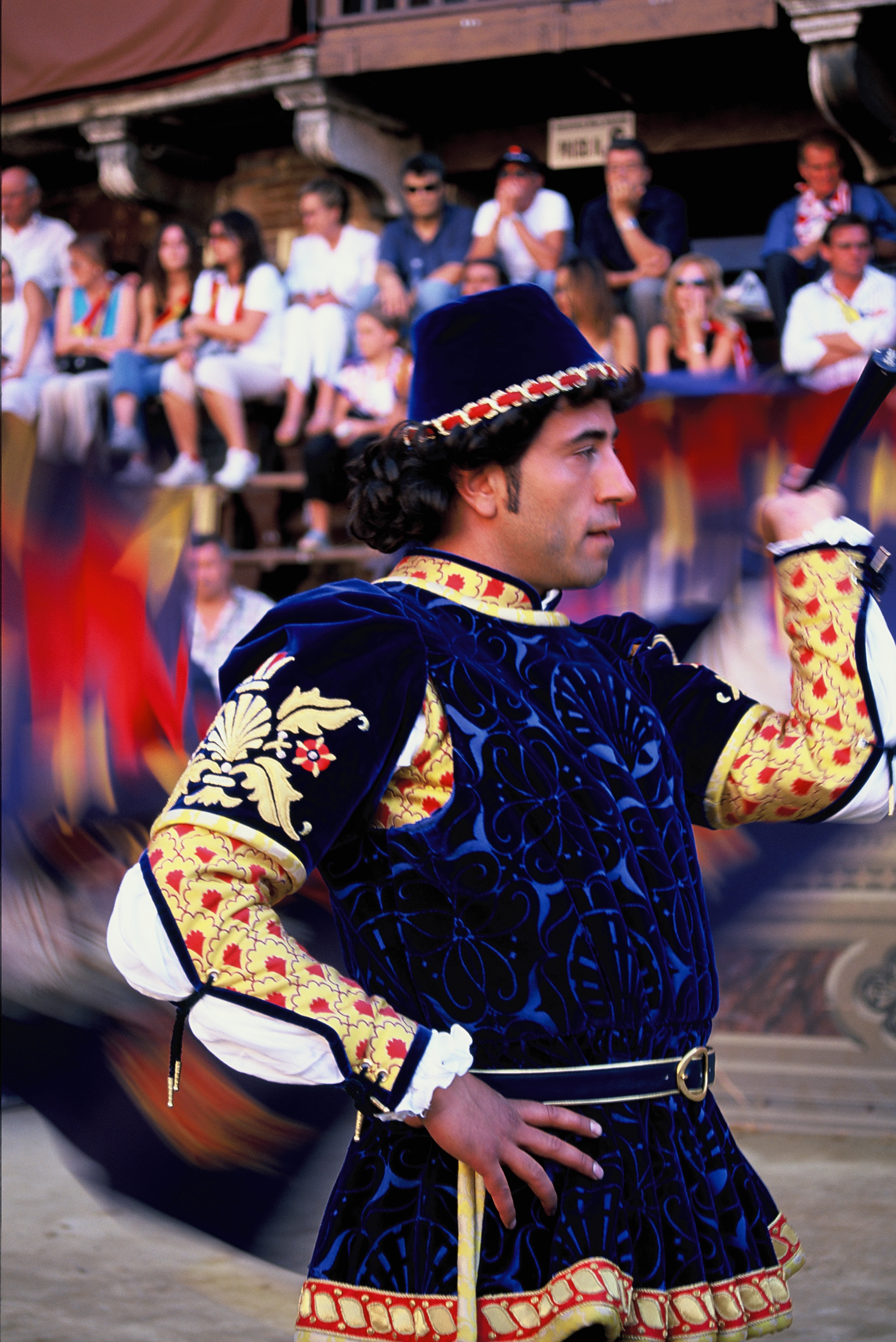
A very serious flag twirler. Image: Don Pinnock
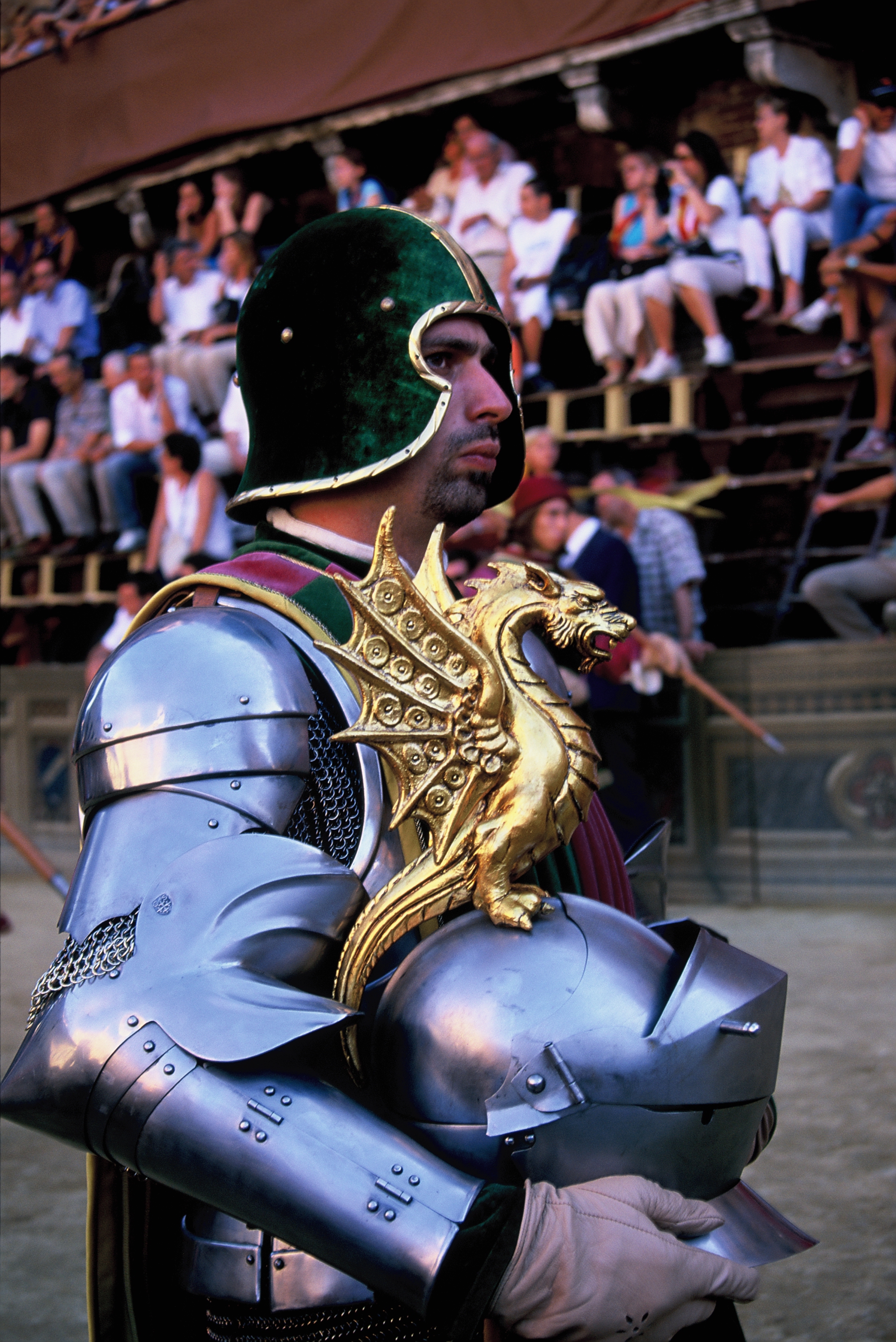
A knight pacing the track with intent. Image: Don Pinnock
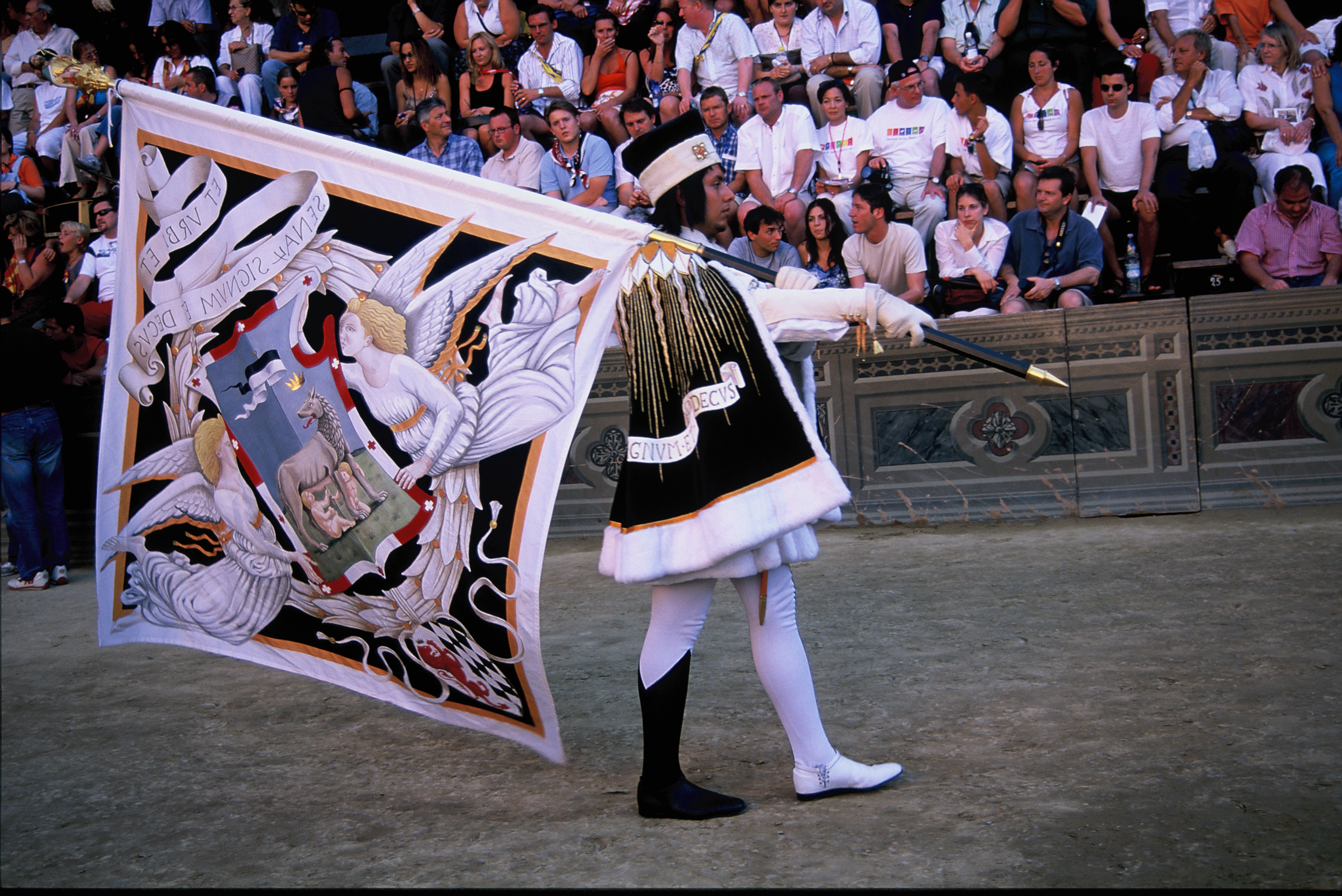
Flags are all-important Palio symbols. Image: Don Pinnock
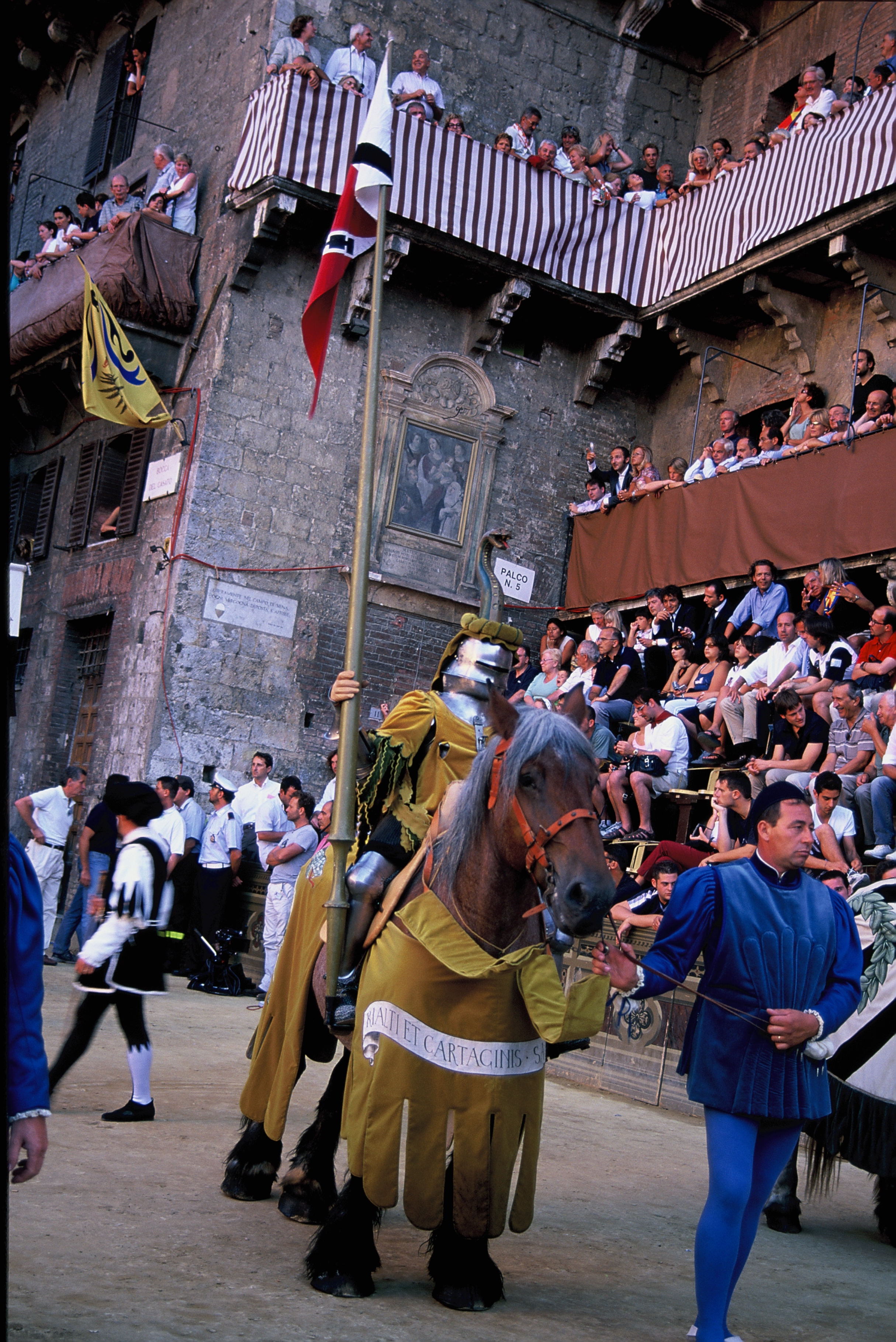
A big knight on a bigger clop-clop. Image: Don Pinnock
The race itself was over in a flash: three circuits of the campo. They thundered off at a speed you can’t imagine bareback riders without stirrups could master.
On one corner a horse and rider crashed into the barrier and went flying, on the second lap another rider fell off and was trampled. He was dragged off senseless, his heels bouncing. Both people and horses have been killed in the past, a sore point with animal rights activists.
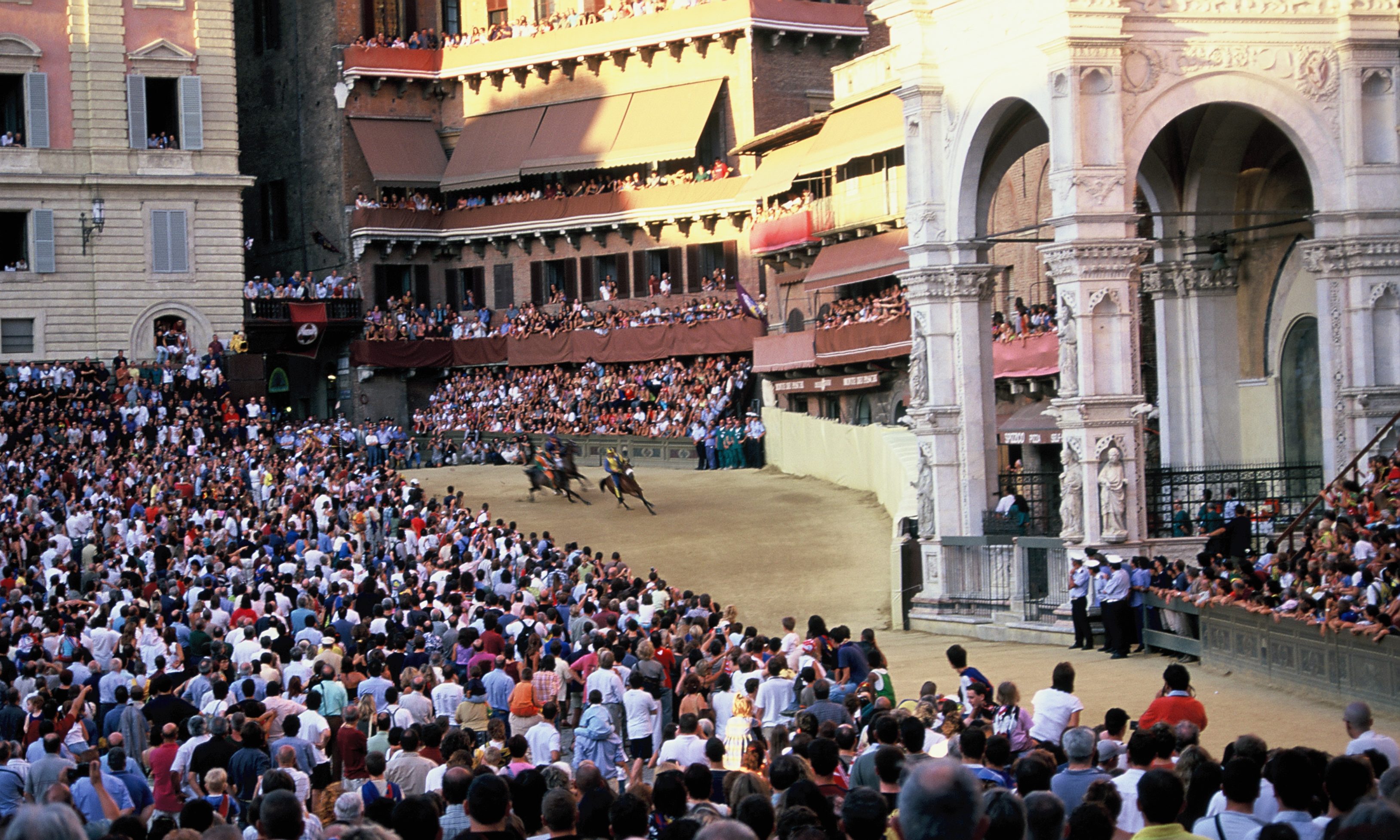
The worst corner. Riders have been known to have been thrown over that fence. Image: Don Pinnock
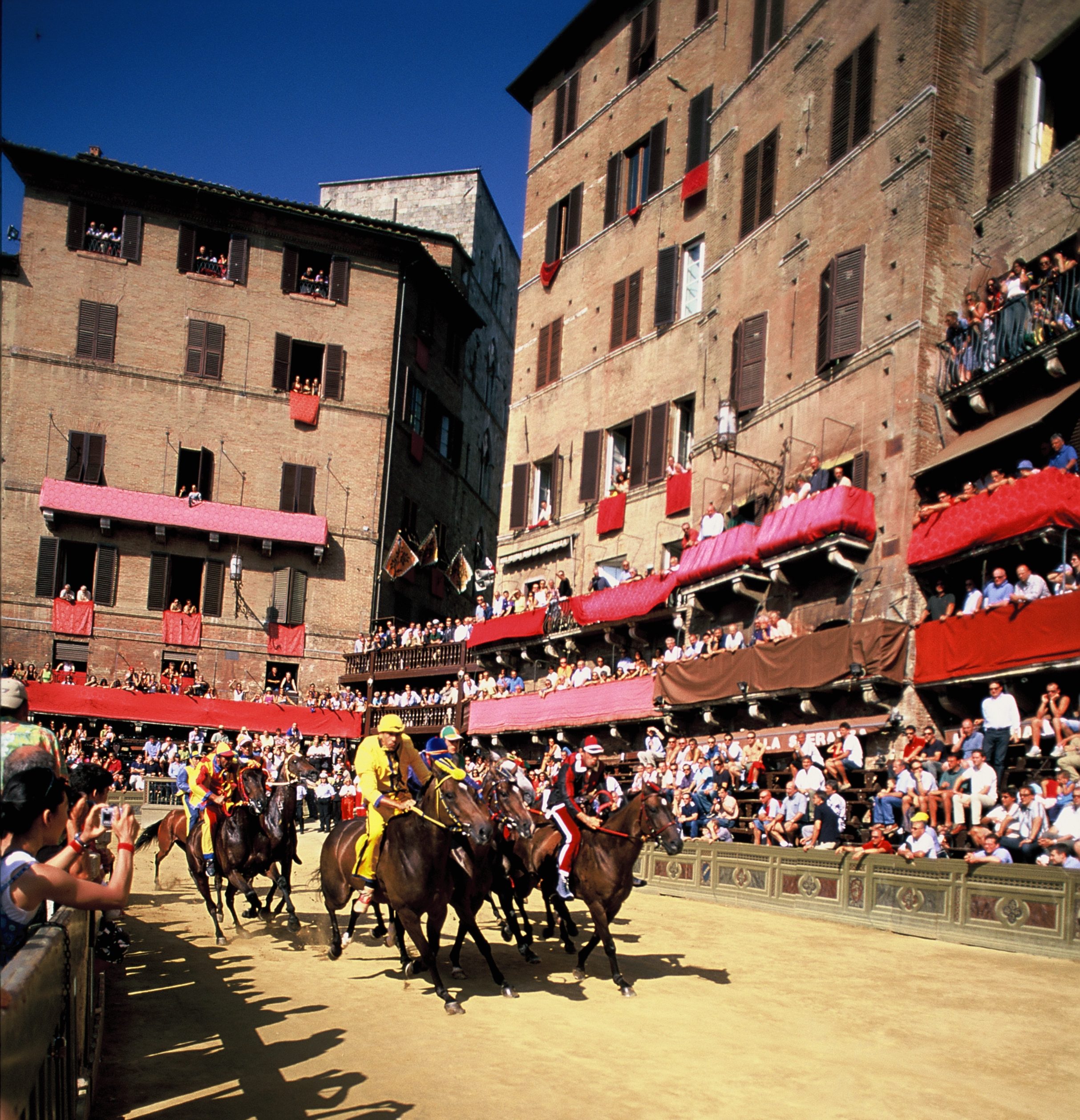
The front runners vying for glory. Image: Don Pinnock
The winner was the Contrada della Selva (the Woodland) symbolised by a rhino and an oak. One section of the crowd went hysterical; elsewhere, people – the losing contradas – wailed and wept openly, tearing their hair.
Next day the clay and barriers were gone, the crowds had drifted away and people were back to lounging in the piazza or licking ice creams at Il Camerlengo. Swallows whizzed and twittered overhead. That the piazza had been a roaring madhouse the previous day was almost unimaginable. But that’s Siena for you: passion, poise and repose – and never more than a hair’s breadth between them. It’s so very Italian.
How to get there and some costs
At time of publication, flights from Johannesburg or Cape Town to Milan or Rome ranged from R8,500 to R13,500 return using Turkish Airlines, British Airways, Emirates or Lufthansa. As always, it is best to shop around, as prices vary depending on school holidays and seasons.
Trains from Milan to Siena cost €30 (R500) to €50 (R850) one way (four- to six-hour trip), and are best booked in advance to avoid price increases. Similarly, one-way train trips from Rome to Siena cost from R200 to R500.
Buses can also be explored and in general – we recommend using www.trainline.com or their equivalent mobile app, for all train and bus bookings and digital ticket storage.
Museums cost about €7 to €15 (R120 to R250) a person but are well worth it. Do be sure to ask about combination tickets that package a few visits into a pass, often valid over three days. Bear in mind that the city in itself is a free museum and walking the streets can be tour enough.
Transport around the inner city is about €2 (R30) a trip. These can be bought at any of the corner stores marked as a Tabaccaio with a large “T” outside. Remember to activate your ticket by stamping it in the machines either on the buses or at the bus stops. This is required for train tickets too, unless you buy them online.
For breakfast, budget about €4 (R16), lunches and dinners can range from €8 (R130) to €25 (R420) a person.
We recommend visiting Key Largo Bar in the Piazza del Campo for coffee and croissants. It is one of Siena’s best-kept secrets. Ask to sit on the balcony and they will take you upstairs to a tight seat that is hands down one of the best places in the world to drink coffee, overlooking the whole Piazza.
Where to stay
Airbnb has many options, but if you stay outside of the walled city, make sure to ask if there are public transport options into town.
We also really like the centrally located Hotel Centrale (www.hotelcentralesiena.it) which charges about €100 (R1,700) for two people per night. Rooms at Hotel Athena found just inside the city’s walls start at €150 (R2,500) for two people per night (www.hotelathena.com).
Things to do
Siena within the city walls is ancient and beautiful. You can spend hours just wandering round, drinking coffee or indulging in its delicious ice creams. Siena’s quaint Romanesque churches cradle priceless art and gleaming gilt altarpieces, its majestic palaces overlook narrow streets and its forbidding walls guard over a community that jealously protects its traditions and history.
Social life revolves around the Campo with its Palazzo Publico – built in 1250 – and Tower of Mangia. It contains the Civic Museum, which has frescoes well worth a visit. The Cathedral, dated at 1136, can absorb an entire day, whether you consider it the most ornate building you’ve ever seen or an overblown wedding cake. It contains the art of countless famous artists, both in the cathedral or its museum. An unfinished portion of the building has a stairway within which leads you to a magnificent view of the city.
The National Picture Gallery (Pinacoteca Nazionale) in the Palazzo Buonsignori has about 700 paintings from the 12th to the 17th century, with probably the greatest collection of works by Lorenzetti in the world. Also accessible to the public are the palaces of Salimbeni, Chigi-Saracini and Tolomei, and the House of St Catherine. An interesting walk is to follow the winding alleys along city walls and explore the many ornate gates within them. Beyond the walls is the beautiful Tuscan countryside with its rolling hills, dark forests and hilltop villages. Don’t miss the 8th-century town of San Gimignano with its outrageous stone towers. It’s an hour away by bus.
High points on the city’s calendar, of course, is the Palio. The famous horse race is run each year on 2 July and 16 August when the town goes crazy. But don’t be deterred – just book your accommodation early. DM/ ML
This story was first written in 2012 and has since been updated to reflect current rates, places to stay and dates of events.
[hearken id=”daily-maverick/9591″]


















Comments - Please login in order to comment.